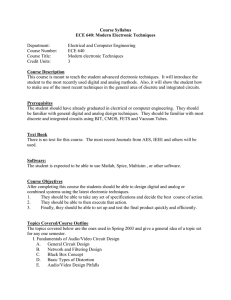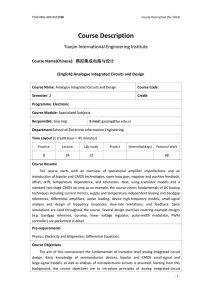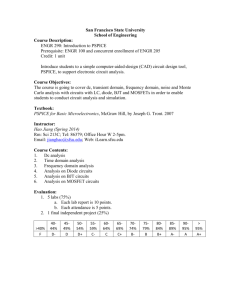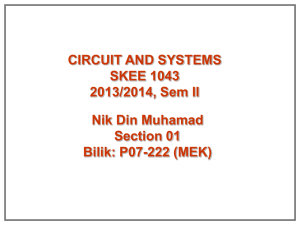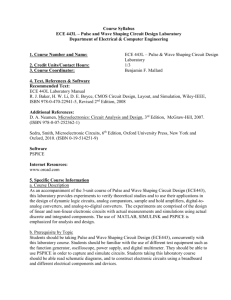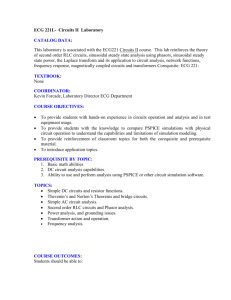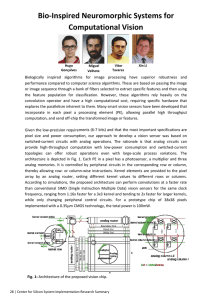ECE 443
advertisement
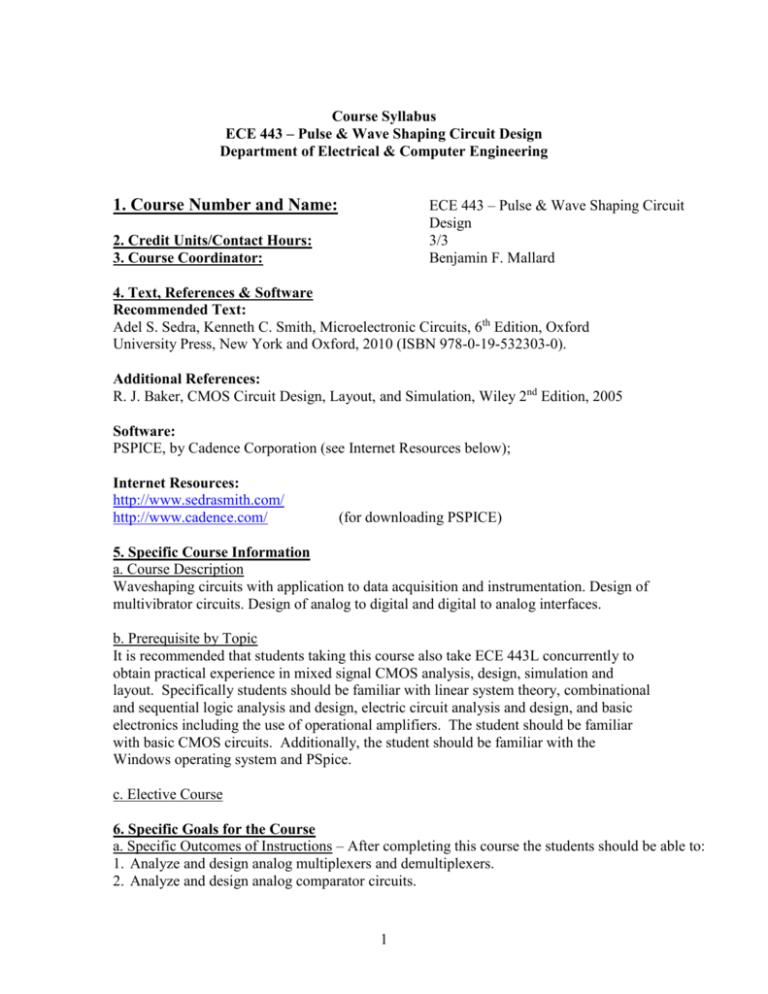
Course Syllabus ECE 443 – Pulse & Wave Shaping Circuit Design Department of Electrical & Computer Engineering ECE 443 – Pulse & Wave Shaping Circuit Design 3/3 Benjamin F. Mallard 1. Course Number and Name: 2. Credit Units/Contact Hours: 3. Course Coordinator: 4. Text, References & Software Recommended Text: Adel S. Sedra, Kenneth C. Smith, Microelectronic Circuits, 6th Edition, Oxford University Press, New York and Oxford, 2010 (ISBN 978-0-19-532303-0). Additional References: R. J. Baker, CMOS Circuit Design, Layout, and Simulation, Wiley 2nd Edition, 2005 Software: PSPICE, by Cadence Corporation (see Internet Resources below); Internet Resources: http://www.sedrasmith.com/ http://www.cadence.com/ (for downloading PSPICE) 5. Specific Course Information a. Course Description Waveshaping circuits with application to data acquisition and instrumentation. Design of multivibrator circuits. Design of analog to digital and digital to analog interfaces. b. Prerequisite by Topic It is recommended that students taking this course also take ECE 443L concurrently to obtain practical experience in mixed signal CMOS analysis, design, simulation and layout. Specifically students should be familiar with linear system theory, combinational and sequential logic analysis and design, electric circuit analysis and design, and basic electronics including the use of operational amplifiers. The student should be familiar with basic CMOS circuits. Additionally, the student should be familiar with the Windows operating system and PSpice. c. Elective Course 6. Specific Goals for the Course a. Specific Outcomes of Instructions – After completing this course the students should be able to: 1. Analyze and design analog multiplexers and demultiplexers. 2. Analyze and design analog comparator circuits. 1 3. 4. 5. 6. Analyze and design analog-to-digital (ADC) converter circuits. Analyze and design digital-to- analog (DAC) converter circuits. Analyze and design voltage controlled oscillators (VCOs). Analyze and design waveform generators b. Relationship to Student Outcomes This supports the achievement of the following student outcomes: a. An ability to apply knowledge of math, science, and engineering to the analysis of electrical and computer engineering problems. b. An ability to design and conduct scientific and engineering experiments, as well as to analyze and interpret data. c. An ability to design systems which include hardware and/or software components within realistic constraints such as cost, manufacturability, safety and environmental concerns. d. An ability to function in multidisciplinary teams. e. An ability to identify, formulate, and solve electrical engineering and computer problems. f. An understanding of ethical and professional responsibility. g. An ability to communicate effectively through written reports and oral presentations. 7. Topics Covered/Course Outline 1. Comparator Design 2. Analog Multiplexers and Demultiplexers 3. Voltage Reference Circuits 4. MOSFET switch 5. Data Converter Basics 6. Sample and Hold Circuit Analysis and Design 7. Data Converter Architectures 8. DAC Analysis and Design 9. ADC Analysis and Design 10. Oversampling approaches 11. Sigma-delta Converter Analysis and Design 12. Phase Looked Loop Analysis and Design Prepared by: Benjamin F. Mallard, Professor of Electrical and Computer Engineering, November 2011 Ali Amini, Professor of Electrical and Computer Engineering, March 2013 2
